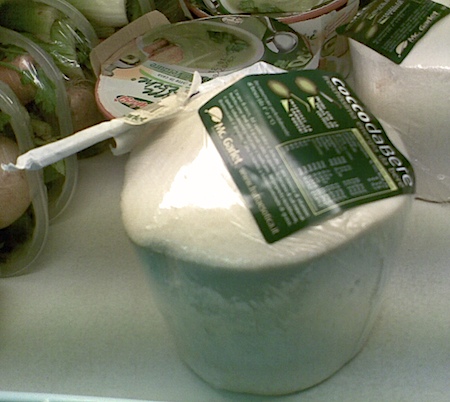I apologise for the quality of this image, but there I was in the local supermarket with only a phone. It shows a shrink-wrapped, cut and trimmed drinking coconut, complete with a straw and instructions for how to make a hole and insert the straw. I was astounded. So astounded that I didn’t register any of the details, like how much these go for, where they are coming from or whether anyone was buying them. If there are any left next time I’ll try to find out. Or maybe this is old news to someone, either in coconut-growing or coconut-drinking country.
Grey horses understood
![]() An easy way to mark yourself as a novice is to call a white horse white. They’re greys. I don’t know why, but there it is. 1 Today, thanks to a paper in Nature Genetics, I do know why they’re grey. 2 Turns out they are over-expressing two genes on horse chromosome 25, thanks to a duplicated bit of DNA 4600 base pairs long. And that’s true in more than 800 greys from 8 different breeds. the duplication has not been found in any non-grey horses.
An easy way to mark yourself as a novice is to call a white horse white. They’re greys. I don’t know why, but there it is. 1 Today, thanks to a paper in Nature Genetics, I do know why they’re grey. 2 Turns out they are over-expressing two genes on horse chromosome 25, thanks to a duplicated bit of DNA 4600 base pairs long. And that’s true in more than 800 greys from 8 different breeds. the duplication has not been found in any non-grey horses.
Greys generally start off with dark hair, but gradually lose the dark pigment, leaving them with white hair and, usually, black-skin. Alas, greys also often develop melanomas that reduce their lifespan, and also show depigmentation of the skin like viteligo in humans. So what’s going on? Leif Andersson and his colleagues suggest that maybe the two genes, called STX17 and NR4A3, may be speeding up the rate of division of pigment cells in the skin and the hair follicles. In the skin, this leads to melanomas. In the hair follicles it depletes the stem cells.
Nibbles: Funding, Grains, Wildflowers, AVRDC, Cloning, Salinity, Education, Sheep dogs, Swans, Writing, Fisheries, Big ag
- Silver lining: IRRI funding up 20% so far this year.
- Foodie discovers diversity: Amaranth, Himalayan Red Rice, Teff, Farro, Triticale, Sorghum … How have I never tried any of these?
- Texans save wildflower seeds.
- “We are not trying to use vegetables as a substitute for food, but rather as an addition to the food basket, to help farmers become better nourished and grow out of poverty.”
- Jurassic Park video.
- Olive varieties differ in response to irrigation with saline water.
- BBC’s One Planet podcast on urban agriculture in Kampala.
- St Kitts kids learn about sweet potato diversity. From the Taiwanese.
- Even in the struggle between shepherd and wolf the issue is uncertain.
- Agricultural biodiversity rituals corner: swan upping. Ah, swan terrine.
- A roundup of Britain’s nature writers. A sort of nature writer upping, I guess.
- Remember that catfish post a couple days back? This completes the trifecta.
- “…the crop from ground, washed, packed and stacked in supermarket-ready trays in just six minutes.”
Better harvests through chemistry
From the blurb at Eldis for a document entitled Fertiliser subsidies and sustainable agricultural growth in Africa: current issues and empirical evidence from Malawi, Zambia, and Kenya.
It is argued that there are compelling rationales for “smart†fertiliser subsidy programmes in Africa. However, achieving these benefits depends greatly on how the programmes are implemented. The authors assert that the contribution of fertiliser subsidy programmes to reducing poverty and hunger would be higher if they could be designed and implemented so as to:
- target households with little ability to afford fertiliser
- target areas where applying fertiliser can actually contribute to yields
- promote the development of a commercial fertiliser distribution system rather than undercutting it
Not sure where I stand on this, to be honest. Fertilizers can be very good news, of course, but if they’re based on fossil fuels then a priori they are not likely to be sustainable. There has to be an overall move towards boosting soil fertility in other ways, making use of nitrogen fixing crops, green manures, bio-char, animal wastes and so on. But in the meantime, if you are going to use fertilizers (as I suspect you must) then those seem to be good policy prescriptions.
The full document is here.
Nibbles: Chips, Free fruit, Ornamentals
- Zebra chip is the latest disease to plague the potato industry.
- Urban fruit: An untapped resource.
- Selling English roses. No, the flowers.
